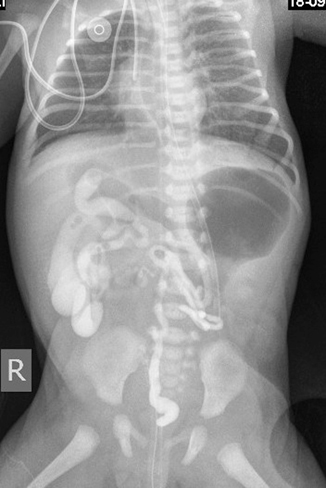Fig. 34.1
Abdominal computed tomography (CT) scan showing markedly dilated urinary bladder (a) and micturating cystourethrogram (b) showing a markedly dilated urinary bladder. There was no evidence of vesicoureteric reflux

Fig. 34.2
Barium enema showing small unused microcolon
MMIHS was first described by Berdon et al. in 1976.
MMIHS usually has a fatal prognosis and in most of the cases infants die within the early months of their lives; nevertheless, there are some case reports of long-term survival.
Etiology
The exact etiology of MMIHS is not known .
The most commonly accepted etiology is that MMIHS is a form of visceral myopathy .
It is a rare congenital anomaly inherited as an autosomal recessive that predominantly affects females (4:1 ratio).
Histological studies suggest that the predominant intestinal manifestation is smooth muscle myopathy.
Molecular observations have linked the disease to the neuronal nicotinic acetylcholine receptor (ηAChR) , namely the absence of a functional α3 subunit of the ηAChR , a de novo deletion of the proximal long arm of chromosome 15 (15q11.2).
Histological evaluation revealed an appropriate light microscopic appearance of both the circular and longitudinal layers of the small bowel muscularis propria.
Immunohistochemical staining for smooth muscle actin, however, was selectively absent in the circular layer, demonstrating isolated absence in a unique and previously undescribed pattern. These observations raise the possibility that the proximal long arm of chromosome 15 (15q11) may be of clinical significance in MMIHS .
Stay updated, free articles. Join our Telegram channel

Full access? Get Clinical Tree


